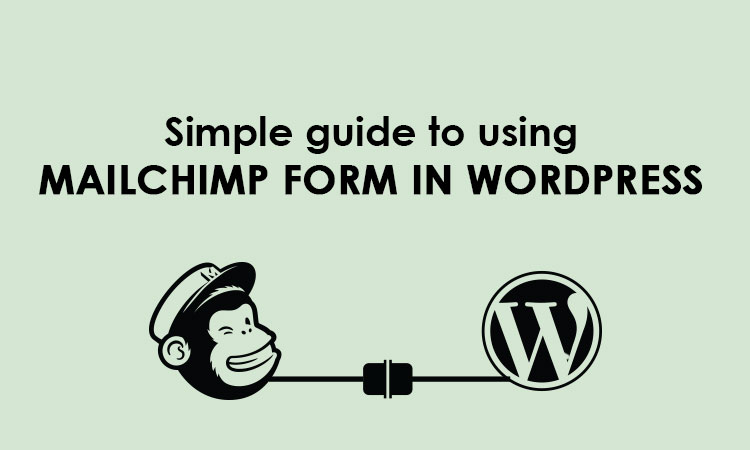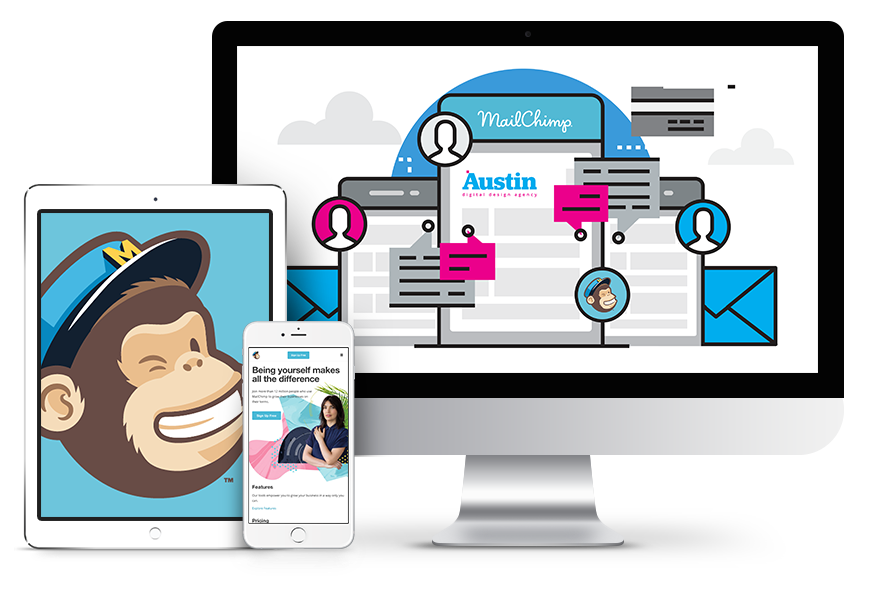Table of Contents

Introduction
WordPress and Mailchimp, Email marketing is a powerful tool that can help businesses reach their target audience, build relationships with customers, and drive conversions. With the right combination of email campaigns and marketing automation, businesses can streamline their marketing efforts and reach more people in a shorter amount of time.
One popular platform for email marketing is Mailchimp, a powerful tool that makes it easy to create, send, and track email campaigns. When combined with WordPress, Mailchimp can take your email marketing efforts to the next level, providing you with an even more effective and efficient way to reach your target audience.
In this blog post, we’ll discuss the benefits of using WordPress and Mailchimp for your email marketing efforts, as well as some tips for maximizing your campaigns. Whether you’re a beginner or an experienced marketer, you’ll find valuable information in this guide that will help you achieve your marketing goals.
WordPress Mailchimp History
The world of digital marketing has come a long way since the early days of the internet. Two of the most prominent players in this space are WordPress and Mailchimp, both of which have revolutionized the way businesses and individuals connect with their audiences online. In this blog, we’ll take a journey through the history of these two platforms, exploring their evolution and how they have become essential tools for digital marketers and bloggers alike.
The Birth of WordPress: WordPress was first launched in 2003 as a simple blogging platform. In the years since its launch, it has grown into the world’s most popular content management system (CMS), powering over 40% of all websites on the internet. One of the key factors in WordPress’ success has been its user-friendly interface and flexibility, making it accessible to both beginners and experienced developers.
The Emergence of Mailchimp: Mailchimp, on the other hand, was founded in 2001 as a simple email marketing service. Over the years, it has evolved into a comprehensive marketing platform, offering a range of tools and services to help businesses grow their online presence. Like WordPress, Mailchimp has become popular due to its user-friendly interface and versatility, making it a go-to tool for digital marketers and businesses of all sizes.
The Evolution of Both Platforms: Over the years, both WordPress and Mailchimp have continued to evolve and improve, responding to the changing needs of the market and keeping pace with new technologies. WordPress has added features like custom post types and a range of plugins, making it a powerful platform for e-commerce, portfolio websites, and much more. Mailchimp, on the other hand, has expanded its services to include tools for social media marketing, landing pages, and automation, making it a one-stop-shop for digital marketing.
The Impact of WordPress and Mailchimp on Digital Marketing: The impact of WordPress and Mailchimp on digital marketing cannot be overstated. These two platforms have democratized the world of digital marketing, making it possible for businesses and individuals of all sizes to connect with their audiences and grow their online presence. Whether you’re a blogger, a small business owner, or a large corporation, WordPress and Mailchimp offer the tools and services you need to succeed online.
WordPress and Mailchimp benefits

In today’s digital age, email marketing has become an essential aspect of any business’s online marketing strategy. Two of the most popular tools used for email marketing are WordPress and Mailchimp. These tools have been used by countless businesses to create and send email campaigns, build email lists, and analyze email marketing metrics. In this article, we’ll discuss the benefits of using WordPress and Mailchimp together to maximize your email marketing strategy.
Firstly, let’s start with WordPress. WordPress is a website building and content management platform that allows you to create and manage websites and blogs. It’s free to use, open-source, and has a wide range of customizable themes and plugins. One of the major advantages of using WordPress for email marketing is that it offers easy integration with Mailchimp. This means that you can easily connect your WordPress site to your Mailchimp account, which will allow you to build email lists and send email campaigns directly from your WordPress dashboard.
One of the most significant benefits of using Mailchimp is that it’s a comprehensive email marketing tool that provides a wide range of features for email marketing. Mailchimp is free for up to 2000 subscribers and allows you to send up to 10,000 emails per month. The platform has a user-friendly interface that makes it easy to create and send email campaigns, design custom templates, and manage email lists. Additionally, Mailchimp provides powerful analytics tools that help you track your email marketing metrics such as open rates, click-through rates, and bounce rates.
One of the most significant benefits of using WordPress and Mailchimp together is the ability to create and manage email lists directly from your WordPress dashboard. This means that you can easily create email lists, segment them based on different criteria, and manage them efficiently. WordPress provides a wide range of plugins that can help you automate this process, such as the Mailchimp for WordPress plugin. This plugin allows you to add opt-in forms to your website, which will allow visitors to subscribe to your email list directly from your website. This will help you grow your email list organically and target your email campaigns to the right audience.
Another advantage of using Mailchimp with WordPress is the ability to create custom email templates. Mailchimp provides a wide range of pre-designed templates that you can use to create your email campaigns. However, if you want to create a custom design that matches your brand’s identity, you can easily do so using Mailchimp’s drag-and-drop editor. Additionally, Mailchimp allows you to preview your email templates on different devices, ensuring that your emails look great on desktop and mobile devices.
WordPress and Mailchimp also provide powerful analytics tools that can help you track your email marketing metrics. Mailchimp provides detailed reports on your email campaigns, including open rates, click-through rates, bounce rates, and more. Additionally, you can use WordPress plugins such as Google Analytics to track your website traffic, which can help you understand how your email campaigns are impacting your website traffic and conversions.
Lastly, using WordPress and Mailchimp together can help you save time and effort by automating your email marketing tasks. Mailchimp provides a range of automation features, such as welcome emails, abandoned cart emails, and post-purchase emails. By automating these tasks, you can free up your time to focus on other aspects of your business.
Why Use WordPress and Mailchimp for Email Marketing?
- Easy Integration: WordPress is an open-source platform that is used by millions of websites around the world. Mailchimp is a popular email marketing tool that is known for its ease of use and flexible integration options. When combined, these two platforms provide a powerful combination that can help you reach your target audience and achieve your marketing goals.
- List Building: Mailchimp provides you with a range of tools for building and managing your email list, including opt-in forms, sign-up forms, and landing pages. These tools are easily integrated into your WordPress website, making it simple to grow your list and target your audience.
- Customization: With Mailchimp, you have the ability to create custom templates and designs for your email campaigns, making it easy to match your brand’s aesthetic. This customization can be extended to your WordPress website through the use of plugins and themes, ensuring a consistent look and feel throughout your marketing efforts.
- Automation: Mailchimp’s automation features allow you to set up email campaigns that are triggered by specific events or actions, such as a user subscribing to your list or making a purchase. This automation can help you save time and reach your audience in a more personalized and effective way.
- Tracking and Analytics: Both WordPress and Mailchimp provide you with valuable tracking and analytics tools, allowing you to measure the success of your email campaigns and make data-driven decisions about your marketing efforts.
Tips for Maximizing Your Email Marketing Efforts with WordPress and Mailchimp
- Optimize Your Opt-in Forms: Your opt-in forms are one of the most important elements of your email marketing efforts, as they are the key to growing your email list and reaching your target audience. To maximize the effectiveness of your opt-in forms, be sure to use a clear and concise call to action, and consider offering incentives such as exclusive content or discounts to encourage people to sign up.
- Segment Your Email List: Segmenting your email list allows you to target specific groups of subscribers with more relevant and personalized messages. With Mailchimp, you can segment your list based on criteria such as location, purchase history, or interests. This targeted approach can help you increase engagement and conversions from your email campaigns.
- Use Personalization: Personalizing your email campaigns can help increase engagement and conversions. With Mailchimp, you can easily add personalization tags to your emails, such as the recipient’s name, location, or other information. This type of customization can help your emails feel more relevant and personalized, leading to better engagement and results.
- Test and Optimize: Continuous testing and optimization is essential for successful email marketing. With Mailchimp, you can easily A/B test different elements of your emails, such as subject lines, calls to action, and content. This allows you to see what works best and make data-driven decisions to improve the performance of your campaigns.
- Automate Your Workflow: Automating your email marketing workflow can help save you time and improve the effectiveness of your campaigns. With Mailchimp, you can set up automated campaigns that are triggered by specific events or actions, such as a user subscribing to your list or making a purchase. This type of automation can help you reach your audience with relevant, timely messages that drive conversions.
Conclusion

- In conclusion, combining WordPress and Mailchimp can help you take your email marketing efforts to the next level. By optimizing your opt-in forms, segmenting your email list, using personalization, testing and optimizing your campaigns, and automating your workflow, you can achieve better engagement and conversions from your email marketing efforts. Whether you’re a beginner or an experienced marketer, these tips and tools can help you achieve your marketing goals and reach your target audience.


